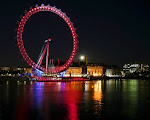Thursday, May 20, 2010
Wednesday, February 10, 2010
Marylebone


Marylebone
Marylebone gets its name from a church called "St Mary's" (now known as St Marylebone Parish Church), which was built on the bank of a small stream or "bourne", called the Tybourne or Tyburn, that rose further north in Swiss Cottage, eventually running along what is now Marylebone Lane before it was built over. The current building was built to the designs of Christopher Wren, 1671-1673, with the 223-foot tower built 1680. It was considered the second most important church in the City of London after St Paul's Cathedral.
Marylebone is in an area of London that can be roughly defined as the area bounded by Oxford Street to the south, Marylebone Road to the north, Edgware Road to the west and Portland Place to the east.
This building was dedicated to St Mary by the Bourne, though it was later renamed St Marylebone. Francis Bacon was married in this church on 11th May 1606.
In 1740 a new church was built on the same site. This was the church the Reverend Charles Wesley must have known during this time in London and it is in the graveyard that Charles Wesley's tomb is to be found. Charles Wesley died in 1788 and it was in this year that Lord Byron was Christened at the church. Lord Nelson attended services in this church, his daughter being Christened on 3rd May 1893.
In 1817 a fourth new building was consecrated. This was built in neo-classical style and designed by Thomas Hardwick. The new church building bordered New Road (now called Marylebone Road). Two famous people were born in the parish in 1812 and both attended the church, Robert Browning and Charles Dickens.
Anna.A
Heura.L
1Batx.A
Monday, February 8, 2010
The Regent's Park


The Regent's Park is one of the royal parks of London. It is in the north zone of the downtown, part in City of Westminster and part in the London Borough of Camden.
The park, of 2 km ², is composed principally by green spaces opened in that one finds a wide range of facilities and services of free time including gardens, a lake with aquatic birds and an area for boats, fields of sport and infantile zones. The extreme north-east of the park shelters the London Zoo, the most ancient zoological garden of the world. Regent's Park has also floral and botanical gardens between which stands out the Queen Mary's Gardens, inside the Inner Circle, where also there is the Open Air Theatre. On the other hand, in the park also they find the London Central Mosque, known also as Regent's Park's mosque, and the Winfield House, official residence of the ambassador of The United States in the United Kingdom and the Regent's College.
The park has an exterior so called round the Outer Circle (4,3 km) and an interior so called round the Inner Circle, which surrounds the area most taken care of the park.
The park is reserved for only people. The sides south, this and great part of the west they are surrounded with elegant rows of white row-houses designed by John Nash.
Jordi R. 1BatxA
Wednesday, February 3, 2010
Notting Hill.


Notting Hill is an area in West London, England close to the north-western corner of Kensington Gardens, in the Royal Borough of Kensington and Chelsea. It is a cosmopolitan district known as the location for the annual Notting Hill Carnival, the setting for the 1999 film Notting Hill starring Julia Roberts and Hugh Grant, and for being home to the Portobello Road Market.
It's an affluent and fashionable area; known for attractive terraces of large Victorian townhouses, and high-end shopping and restaurants.However, the large houses have also provided multi-occupancy rentals for much of the 20th century, attracting Caribbean immigrants in the 1950s.
Notting Hill Carnival is an annual event in August, over two days (Sunday and the following bank holiday).It has continuously taken place since 1965.The carnival has attracted up to 1.5 million people in the past, putting it among the largest street festivals in Europe.
Laura C. and Lorena A. 1st Batx.A
Camden Town



Camden Town is a station of the Northern Line, is an underground railway in London, coloured black on the London Underground Tube map, located in the London District of Camden. Nevertheless, the environs of the station are famous to lodge one of the variable and outlandish street markets more of all London. The district is located at 3.7 quilometres to the northwest of Charing Cross. The adminisered extreme unction to area receives every weekend tourists of all the corners of the world and is a center of alternative ways of life. Camden Town is seen like the capital of the alternative rock of Great Britain and, by extension, probably of the world. the known stores but are: The black cap (pub), The world’s end (pub), The underworld (live music), Electric Ballroom (night club), The new goodfare (restaurant), Cyberdog (punk clothes), others.
1st Batx. A Albert B & Judit A.
Subscribe to:
Posts (Atom)
